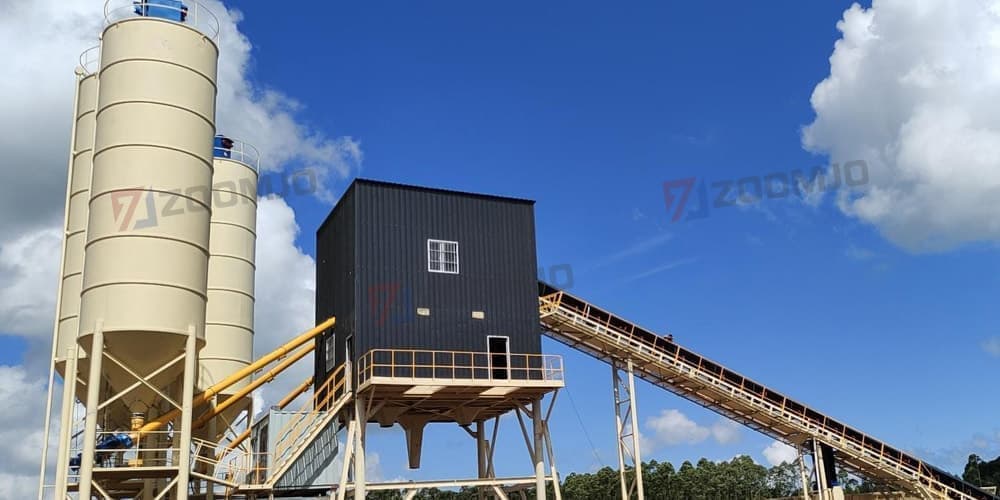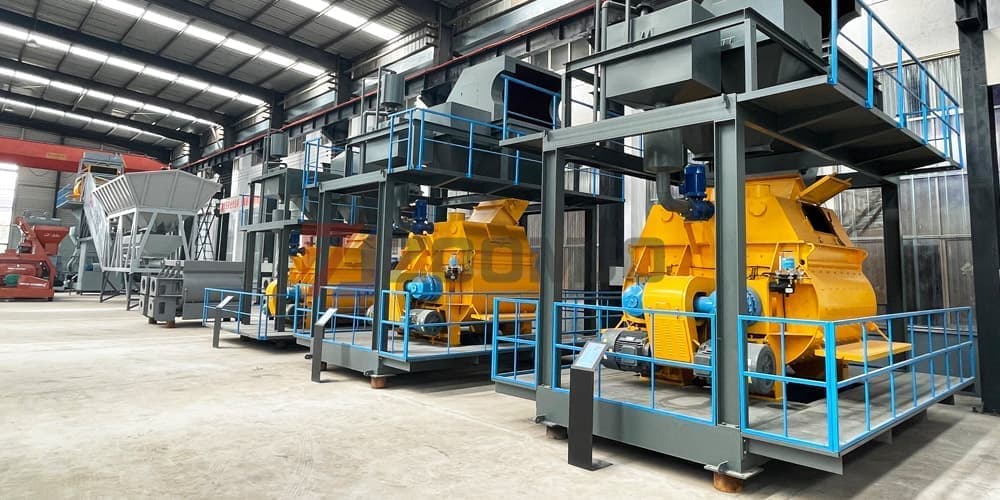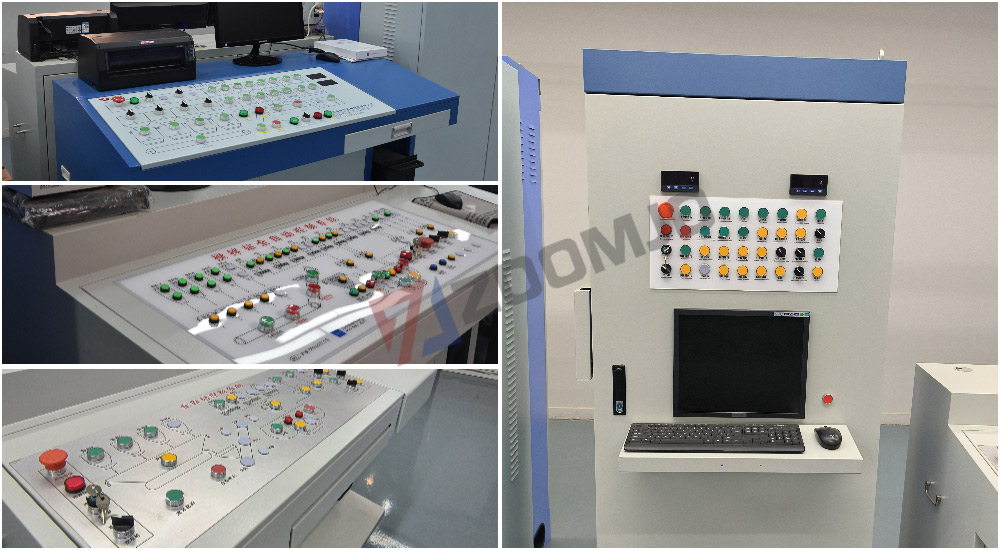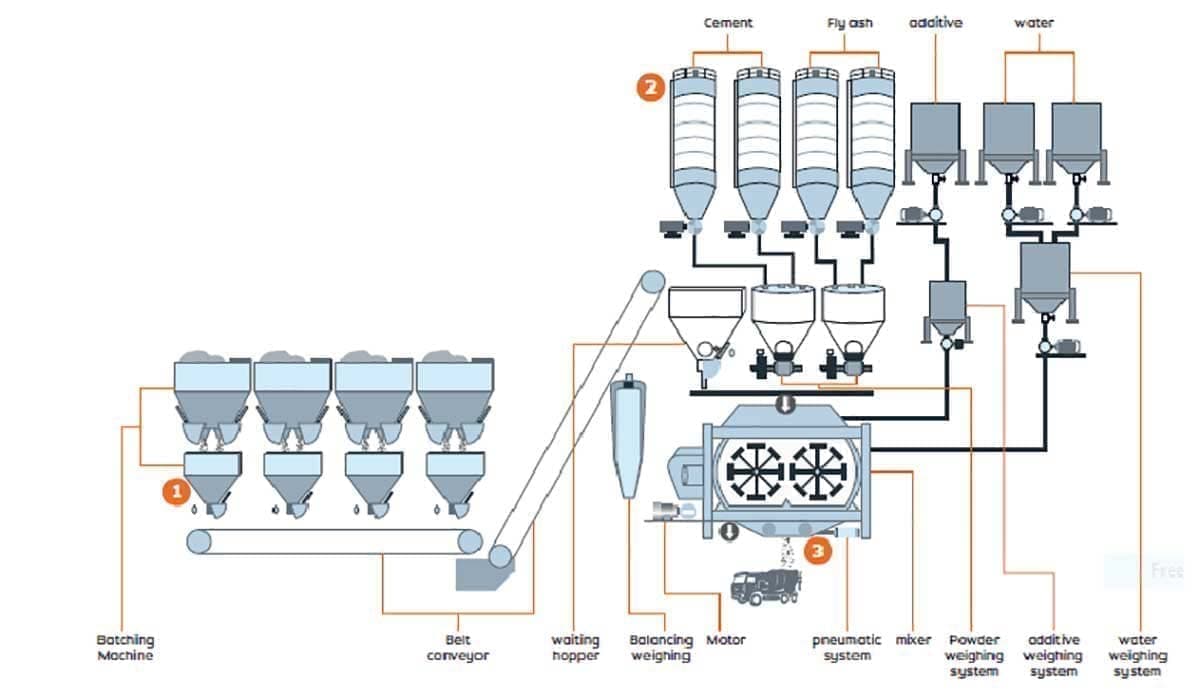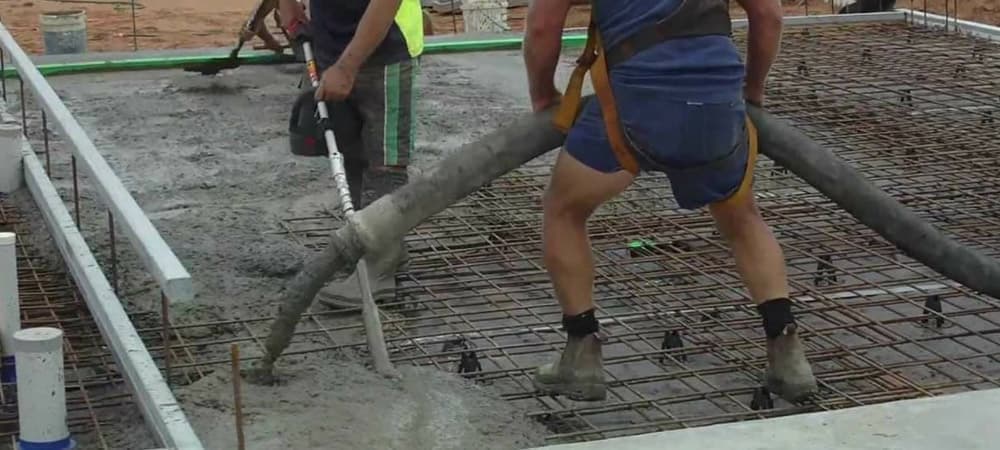How the Concrete Batching Plant Works?

As a professional concrete mixing plant manufacturer, we understand that concrete batching plant plays a vital role in modern construction projects. It efficiently and precisely mixes various raw materials into high-quality concrete, laying a solid foundation for all kinds of construction projects. In this article, we will deeply analyse the working principle of concrete batching plant from a professional point of view.
Definition and Classification of Concrete Batching Plant
Concrete batching plant, also known as batching plant, is a complete set of equipment used to measure and mix sand, stone, cement, water, and other admixtures (such as fly ash, admixtures, etc.) in accordance with predetermined proportions, and finally produce concrete. According to the mixing method and production process, it can be divided into the following two main types:
-
Ready-mix plant (dry mixing plant): All ingredients (sand, stone, cement, admixtures) except water are mixed well in the mixing plant to form a dry mix, which is then unloaded into ready-mix trucks (concrete trucks), and water is added to mix it during transport or after it arrives at the site.
-
Central mixing plant (wet mixing plant): All ingredients (including water) are mixed in the mixing plant to produce finished concrete directly, which is then transported to the construction site by concrete mixer trucks.
Central mixing plants provide better control over the quality of concrete compared to ready-mixed plants, as the mixing of all components takes place in a central location and is controlled by computer-aided control, ensuring consistency and stability of the product.
Concrete Batching Plant Core Components Explained
A complete concrete mixing plant consists of several core systems that collaborate with each other to complete the production of concrete. Below is a detailed description of each system:
Aggregate supply system
Aggregate is the main component of concrete, including sand and stone, playing the role of skeleton support. The core function of the aggregate supply system is to efficiently, stably and accurately complete the storage, conveying and metering of aggregates, laying the foundation for the final quality of concrete.
Aggregate silo: It is used to store different sizes of aggregates, which are separated according to the particle size to meet the requirements of different concrete ratios.
-
Quantity: Usually 3-6, according to the type of stored aggregates. Common configuration:
-
3 bins: coarse aggregate (such as 20-40mm stone), medium aggregate (such as 10-20mm stone), fine aggregate (sand).
-
4 bins: add extra fine sand or mechanism sand bins on the basis of the above.
-
5-6 bins: for storing more kinds of aggregates to meet the demand of special concrete production.
-
Capacity: Depends on the production capacity of the concrete mixing plant and the aggregate turnover cycle:
-
Small mixing plant: 10-30 cubic metres/bin.
-
Medium-sized plant: 30-50 cubic metres/bin.
-
Large plant: 50-100 cubic metres/bin or more.
-
Structure form:
-
Ground silo: simple structure, low cost, large area, suitable for open site.
-
Semi-underground silo: reduce the area, reduce the loading height, the construction is more complicated, need to do a good job of waterproofing and drainage.
-
Elevated silo: the use of gravity discharge, improve efficiency, reduce the number of conveying equipment, high cost, high requirements for the foundation, applicable to large stations or sites restricted occasions.
-
Inner wall treatment: In order to prevent bonding and clogging, the inner wall is often made of smooth materials (such as steel plate lining, wear-resistant coating), and equipped with vibrators or pneumatic arch-breaking devices.

Conveying equipment: Conveys the aggregate from the silo to the dosing unit or mixer.
-
Belt conveyor: widely used, simple structure, large conveying capacity, easy maintenance. According to the conveying distance, volume and material characteristics to choose the appropriate belt width, speed and inclination angle.
-
Elevating bucket: used for vertical lifting of aggregates in occasions with limited space, suitable for small and medium-sized stations. There are ring chain and plate chain types, which are selected according to the lifting height and volume.
-
Inclined Belt Conveyor: Inclined conveying, the angle is generally not more than 20 degrees, a larger angle needs to be used to prevent slippage of the edge belt.
Measuring system: to ensure the accuracy of proportioning.
-
Electronic weighing device: High-precision load cell, accuracy up to ±2% or higher.
-
Multi-bin metering: Each bin corresponds to a metering hopper, measuring multiple aggregates at the same time.
-
Belt conveyor metering: Load cell is installed on the belt conveyor to achieve continuous metering.
Powder supply system
Powder materials (cement, fly ash, slag powder, etc.) play a cementing role in concrete. This system is responsible for the safe and efficient storage, conveying and metering of powdered materials.
Cement silos (cement tanks): Store cement.
-
Capacity: Depends on the production capacity of the mixing station, cement turnover cycle and availability:
-
Small stations: 1-2, 50-100 tonnes each.
-
Medium-sized stations: 2-4, 100-200 tonnes/unit.
-
Large stations: 4 or more, 200 tonnes/unit or larger.
-
Quantity: Depends on the type of cement to be stored.
-
Form of construction: Usually steel structure, sealed against moisture.
-
Welding type: Integral, airtight, good strength, high cost, complicated installation, suitable for large stations.
-
Assembled type (piece mounted): module assembly, easy to transport and install, lower cost, suitable for small and medium-sized stations or occasions requiring frequent relocation.
-
Accessory equipment:
-
Dust collector (silo top dust collector): filtering dust, reducing pollution. Common types: bag type, pulse type.
-
Material level meter: detect the material level, monitor and alarm. Common types: spin-resistant, radar, ultrasonic.
-
Arch-breaking device (pneumatic arch-breaker/air cannon): prevent cement from clumping and ensure smooth discharge.
-
Safety valve (pressure relief valve): prevent abnormal pressure in the silo.
-
Climbing ladder and guardrail: convenient for maintenance and overhaul.

Fly ash silo: Storage of fly ash in a similar configuration to the cement silo.
-
Special treatment: The inner wall needs anti-corrosion treatment (e.g. coating, corrosion-resistant materials).
-
Improvement of flow: Configuration of more effective arch-breaking and flow-assisting devices (e.g. gasification devices, vibrators).
Screw conveyor: To transport the powder from the silo to the dosing unit.
-
Types: Horizontal, Inclined, Vertical.
-
Model: According to the conveying capacity, distance and material characteristics, common models are LSY series, GX series and so on.
-
Features: simple structure, low cost, high efficiency, limited conveying distance, easy to wear.
Water supply and admixture supply system
This system is responsible for the storage, metering and delivery of water and admixture.
-
Tank: Stores water, usually of reinforced concrete or steel construction, which needs to be kept clean and washed regularly.
-
Pump: Transfers the water to the metering unit or mixer.
Metering device: Accurately measures the amount of water used, usually by means of a flow meter or weighing.
-
Admixture storage tank: storage of various admixtures, according to the characteristics of the admixture to choose the appropriate material, and anti-corrosion treatment.
-
Admixture metering device: accurate measurement of the amount of admixture, usually using volumetric or gravimetric measurement.
Mixing system
This system mixes various materials into homogeneous concrete.
Concrete Mixer:
-
Tilting Mixer: Tilting mixer is a more traditional mixing equipment, and its working principle is relatively simple. The mixing drum is installed in an inclined shape, and through the rotation of the mixing blades, the aggregate, cement, water and other ingredients are tumbled and mixed in the drum. This type of mixer can provide stable mixing effect, and the structure is relatively simple, low maintenance and labour costs, suitable for ordinary projects that do not require particularly high uniformity of concrete mixing.
-
Double horizontal shaft forced mixer: double shaft mixer is more advanced, its working principle is through two parallel mixing shafts, the shaft is equipped with staggered mixing blades, in order to high-speed rotation of the ingredients for strong mixing. This type of mixing ensures a more homogeneous concrete mix, which is especially suitable for the production of special concrete with high requirements for homogeneity, such as high-performance concrete, fibre-reinforced concrete and so on. At the same time, the output of the twin-shaft mixer is relatively large, which can meet the needs of large-scale concrete production.
-
Plate mixer: The working principle of plate concrete mixer is to use a horizontally placed mixing disc, which is equipped with several mixing blades. The mixing disc in the process of rotation, so that the ingredients in the disc to form a vortex, to achieve full mixing. Disc mixer has the advantages of high mixing efficiency, good mixing uniformity, strong adaptability to aggregate size, etc. It is suitable for a variety of types of concrete production, especially in the production of some special aggregate concrete with excellent performance.
Discharge device: Discharge the concrete from the mixer, usually with pneumatic or hydraulic control of the discharge gate.
Control system
Controls the automated operation of the entire production process.
-
Computer control system: industrial computer and PLC composition, control batching, mixing, unloading and so on.
-
Operation interface: human-machine interface (HMI) for parameter setting, process monitoring and data recording.
-
Sensors and actuators: sensors detect production parameters, actuators execute control instructions.
Working principle and process of concrete batching plant
The workflow of concrete batching plant is rigorous and orderly, interlocking, any one link of negligence may affect the quality of the final concrete.
1. Aggregate feeding and weighing
Firstly, aggregate materials such as sand and gravel are fed into the bin of the aggregate feeder. After that, the aggregate weighing conveyor is activated to convey the aggregates from the silo to the weighing hopper, and the aggregates are accurately weighed during the conveying process. The weighing system strictly controls the amount of aggregate placed according to the preset aggregate proportion, ensuring that the aggregate proportion is accurate.
2. Dosing and mixing
When the aggregate weighing reaches the standard, the weighing hopper opens automatically and the aggregate falls into the mixer. At the same time, fly ash, cement and other powders are transported from their respective tanks to the weighing hopper through screw conveyor, and water and additives are also accurately measured according to the preset proportion and then flow into the weighing hopper. All the ingredients are gathered in the mixer, which then starts to mix the ingredients according to the preset mixing time and method. During the mixing process, the blades or mixing shaft of the mixer rotate at high speed, so that the aggregate, cement, water and additives are fully mixed to form a uniform concrete paste.
3. Concrete unloading and transport
After mixing is completed, the loading door of the mixer is opened and the concrete flows into the waiting concrete mixer truck or pump truck below. Extreme care must be taken during this process as any segregation of the concrete will seriously affect its quality and performance. At the same time, the concrete must be prepared, transported and ready for use before the initial setting time of 30 - 45 minutes, which requires that the productivity of the batching plant and the speed of unloading must be closely matched to the construction schedule to ensure that the concrete is ready for use in optimum condition.
Throughout the production process, the control system plays a vital role in precisely controlling the ratio of the various materials, mixing times and other parameters to ensure that the quality of the concrete meets the requirements.
Modern concrete batching plant generally adopts highly automated control system. The system usually consists of an upper computer and a lower computer, the upper computer is responsible for overall monitoring and data processing, while the lower computer controls the specific weighing, feeding and mixing operations. Through sensors and electronic scales, the control system is able to monitor the status of all kinds of materials in real time to ensure the accuracy and stability of the production process.
Key factors affecting the quality of concrete
The quality of concrete is the result of a combination of factors, and negligence in any one of them may result in a substandard final product. The following are the key factors affecting the quality of concrete:
-
1. Quality of raw materials : Raw materials are the foundation of concrete, and their quality directly determines the potential performance of concrete. The strength grade, stability, heat of hydration and other indexes of cement directly affect the strength and durability of concrete; the grading, strength, mud content and particle shape of aggregates affect the compatibility, strength and durability of concrete; the type, amount and activity of admixtures (such as fly ash, slag powder) affect the properties of concrete; the type, amount and adaptability to the cement affect the working and hardening properties of concrete; the water quality of mixing water must also meet the standards to avoid impurities adversely affecting the performance of concrete. Hardening properties; the water quality of mixing water must also meet the standards to avoid impurities adversely affecting the performance of concrete. Therefore, strict control of the quality of raw materials is the first link to ensure the quality of concrete.
-
2. Mixing ratio design: The mixing ratio is a key parameter to determine the proportion of various raw materials used in concrete. Among them, the water-cement ratio is one of the most important factors affecting the strength of concrete, the smaller the water-cement ratio, the higher the strength of concrete, but too small will affect the ease of use; the amount of cementitious materials (cement and admixtures) affects the strength and durability of concrete; the amount of aggregate affects the ease of use of concrete and the economy; the amount of admixtures need to be adjusted according to the specific conditions to achieve the best results. Scientific and reasonable proportion design is an important guarantee to ensure that the concrete performance meets the design requirements.
-
3. Mixing uniformity: Mixing is the process of mixing all kinds of raw materials evenly, and its uniformity directly affects the uniformity of concrete properties. The performance of mixer (type, mixing blade design, etc.) and mixing time are the main factors affecting mixing uniformity. Insufficient mixing time will lead to uneven mixing of concrete and large differences in the performance of each part; too long a mixing time may lead to segregation of concrete, which also affects the uniformity. Therefore, it is important to choose a suitable mixer and control the mixing time reasonably.
-
4. Measuring accuracy: The measuring accuracy of various raw materials directly affects the actual proportion of concrete, thus affecting the final performance of concrete. Modern mixing plants usually adopt high-precision electronic weighing systems to minimise measurement errors. Regular calibration and maintenance of metering equipment are important measures to ensure metering accuracy.
-
5. Construction process: The construction process includes transporting, placing, vibrating and curing of concrete, the quality control of which is crucial to the final performance of concrete. Concrete segregation and slump loss should be avoided during transport; pouring should be carried out in layers to avoid cold joints; vibration should be adequate, but avoid over vibration; curing is the key to ensure the normal development of concrete strength, and suitable curing methods and curing time should be selected according to the environmental conditions and the type of concrete.
-
6. Control system stability: the control system is the "brain" of the concrete mixing plant, and its stability directly affects the stability and reliability of the entire production process. Stable control system can ensure the automation and standardisation of the concrete production process, reduce human error, improve production efficiency and product quality consistency.
-
7. Environmental factors: Environmental factors such as temperature, humidity, etc. will also affect the performance of concrete. For example, low temperature will slow down the hydration rate of cement and affect the early strength development; high temperature may lead to early dehydration of concrete and cracks. Therefore, it is necessary to take appropriate measures according to the environmental conditions during construction, such as heat preservation measures for winter construction and humidity preservation measures for summer construction.
About Us
ZOOMJO is a leading manufacturer of concrete mixing plant and crushing equipment in China, with 29 years of rich experience in the industry, we are committed to providing high-quality and high-performance solutions to our customers around the world. We specialise in concrete mixing and our product line covers a wide range of types, including:
-
Stationary Concrete Batching Plant: Suitable for large-scale projects, featuring high productivity and good stability.
-
Mobile Concrete Batching Plant: Flexible, easy to relocate and quick to install, suitable for projects with short construction period and unfixed site.
-
Foundationless Concrete Batching Plant: Easy to install, no need for complex site foundation construction, reducing the project investment.
-
Dry Concrete Batching Plant: Mixing dry materials such as aggregate and cement, and then transporting them to the construction site with water for mixing, which is suitable for projects that do not require high slump of concrete.
-
Wet Concrete Mixing Plant (Centralised Mixing Plant): All materials (including water) are mixed in the mixing plant, and the finished concrete is produced directly with more accurate quality control.
-
Ready-mixed Concrete Batching Plant: Focuses on the production and supply of ready-mixed concrete, which can meet the demand for large-scale and continuous concrete.
We can provide customised concrete mixing plant solutions according to the specific needs of our customers, covering a wide range of sizes from small to large to meet different scales and types of projects.
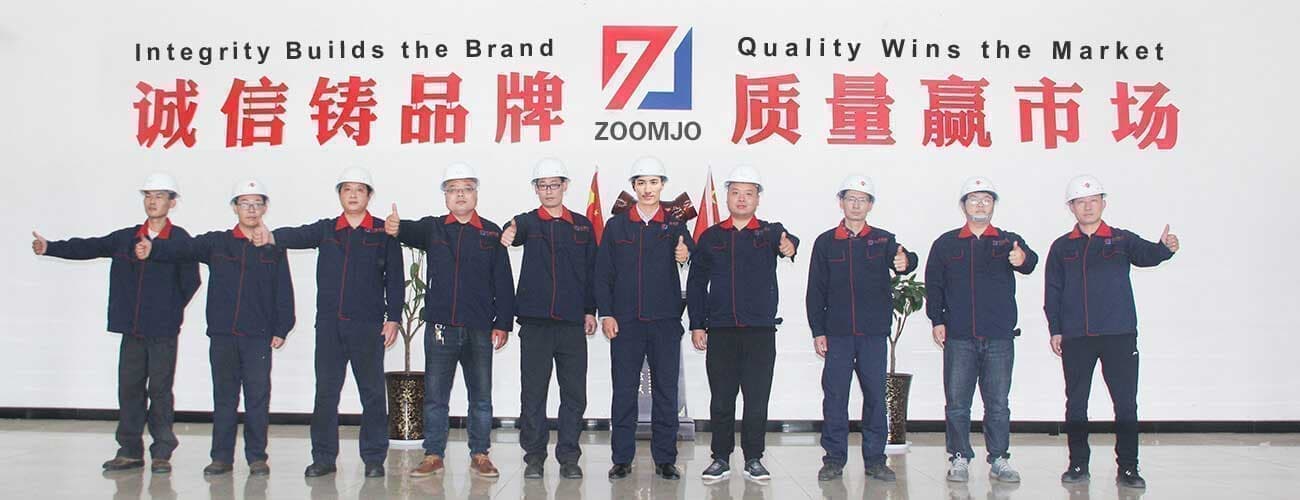
In addition to concrete mixing plants, ZOOMJO also has strong crushing equipment manufacturing capabilities, providing various types of crushers as well as complete sand and gravel crushing production lines, providing one-stop solutions for aggregate production.
If you need concrete mixing plant, please feel free to contact us. We will be happy to provide you with all-round, one-stop solution from programme design, equipment manufacturing, installation and commissioning to after-sales service, and help you make your project successful!

 English
English  Español
Español  简体中文
简体中文  Pусский
Pусский  українська
українська 